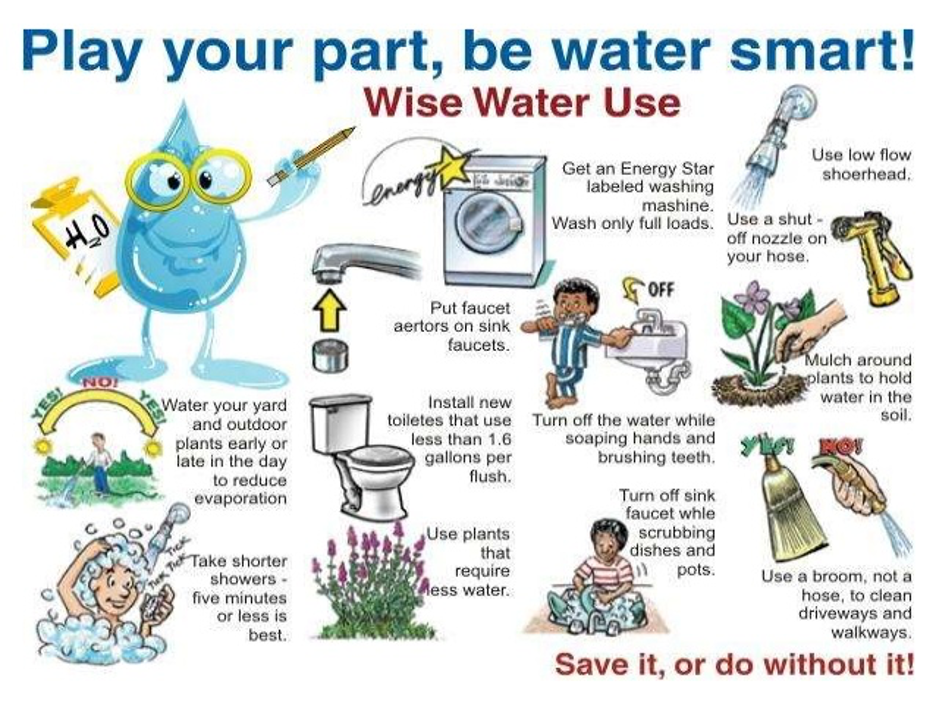Water Conservation
Water is essential to our daily lives. Whenever it is used, there is a potential for water conservation both inside and outside of your home. It is important to remember that care in our water use habits should not only be taken in times of water shortage. Sensible water use can reduce the amount of stress that is placed on our resources, both by limiting water withdrawals and by decreasing wastewater distribution. Conserving water reduces wear and tear on major resources such as water and wastewater treatment plants and the distribution systems that deliver water to the public. Using less water can also enable us to become more flexible during times when there is a water shortage. Here are some helpful tips for water conservation.

Inside
- Install aerator attachments on sink faucets. These are known to reduce water use by 25%. To avoid bacterial growth it is recommended that the aerator be sanitized once per month.
- Replace or adapt older, less water efficient fixtures or appliances. A lot of innovative water saving devices are available on the market that can reduce water use up to 40%.
- Take shorter showers. Replace your shower-head with a water saving device such as an ultra-low-flow version. Some units are available that allow you to cut off the flow without adjusting the water temperature. Showers can also be equipped with shut-off valves that allow a person to stop water flow while soaping and shampooing.
- When bathing, be careful not to overfill the tub. A ¼ full tub is usually sufficient.
- Don’t let water run while shaving, washing your face or brushing your teeth.
- Avoid flushing the toilet unnecessarily. Dispose of tissues and other similar waste in the trash rather than the toilet. The average person uses well over 100 litres of water per day just by flushing the toilet, which accounts for 45% of a person’s total indoor water use.
- When replacing a toilet, consider a low-flush toilet that uses a smaller water tank. Or you can install a water saving device in your present toilet to reduce the amount of water used during a flushing cycle. For more information on water conservation innovations you should consult your local plumbing supply or hardware store.
- Operate automatic dishwashers and washing machines only when they are fully loaded. Set the water level for the size of load you are using.
- When washing dishes by hand: If you have two sinks, partially fill one with soapy water and the other with rinse water. If you only have one sink, gather washed dishes in a dish rack and rinse them with a spray device or rinse them in a pan full of hot water.
- If something requires cleaning fill the sink instead of running a steady stream of water.
- When boiling vegetables use just enough water to cover them or consider steaming, which uses less water and also conserves the natural nutrients.
- Do not use running water to thaw meat or other frozen foods. Instead consider defrosting food overnight in the refrigerator or using the defrost setting on your microwave.
- Kitchen sink disposals require a lot of water to operate properly. Consider starting a compost pile as an alternative to this method of disposing of most food wastes.
- To prevent dripping faucets be sure all taps are turned off tightly but gently. Even just one drop per second from a leaky faucet can waste up to 10,000 litres of water per year.
- Store drinking water in the refrigerator. Do not let the tap run while you are waiting for cool water to flow.
- Check regularly for leaks in faucets, pipes, taps, hoses and dishwasher and washing machine fittings. If a leak is detected it should be repaired promptly.
- Insulate your water pipes so hot water is more readily available. This avoids wasting water while it heats up. This can also prevent your pipes from freezing in the colder months.
Outside
- Use a broom to clean a driveway or a sidewalk rather than spraying it down with water.
- Watering outdoor greenery in the spring isn’t always a good practice. The less it is watered early in the growing season, the deeper the roots will grow. This creates a greater natural reservoir.
- For lawn and garden watering use an appropriate sprinkler with an automatic shut-off nozzle that best suits your needs. Lawns should be watered no more than once every 3 to 5 days. Remember, evaporation rates are lower in the morning or early evening. At times when there are water shortages, lawns should not be watered at all.
- Ask your local gardener about drought resistant plants and ground coverings that will save upkeep time and water.
- Install moisture-holding mulch around trees and shrubs and keep weeds under control. Weeds can prevent much needed water from reaching other plants.
- Rainwater can be collected in large containers and used to water outdoor plants.
- When washing your car use a bucket and sponge, then quickly rinse with a trigger nozzle equipped hose.
- By not overfilling your swimming pool you can prevent water loss due to splashing. Swimming pool covers can also be used to prevent evaporation.
Water supplies in our province are more likely to remain fairly constant from season to season, but the rate at which people use water rises sharply in the summer. During the summer season water demand nearly doubles, so water conservation is most crucial.
It is important to be aware of and to follow all water conservation and water shortage directives in effect in your community, and especially important to observe good water use rules if your water is from a private well.
Try to do something that will result in water conservation each day,
no matter how small. Every drop counts!
